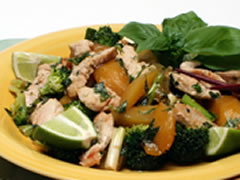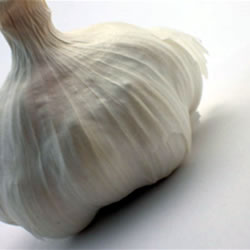To reach the goal of five or more servings a day of vegetables and fruits, eating salads is indispensable. Enjoying them calls for variety. But to many Americans, a salad means just one thing, namely a bowl of lettuce eaten on the side, perhaps accompanied by cucumber slices, a few cherry tomatoes, or shreds and slices of a few other vegetables. (If you dine in sophisticated circles, the greens may be the blend of baby leaves the French call "mesclun.")
In the traditional Asian diet, salads with big, bold flavor play an important role. They include ingredients familiar to us, but used in different ways. They also incorporate foods that are sold at many supermarkets but aren't often thought of as salad ingredients. Here are ideas inspired by classic Asian salads.
"Table Salad" is a platter heaped with whole lettuce leaves, shredded carrots, cucumber, bean sprouts and fresh mint, basil and cilantro. Placed in the center of the table, it is an integral part of most Vietnamese meals. Everyone helps themselves to whatever they want, using lettuce leaves as a wrap to hold the other vegetables and a little of the cooked foods, like sates and noodle- or rice-based dishes. A Western-style version might include thin slices of roast chicken to wrap inside a tender leaf lettuce packet, along with other vegetables and fresh herbs. Serve small bowls of a lemony, soy sauce-based dressing. Eat your salad out-of-hand, dip it in the dressing and munch away.
The Japanese love Ohitashi, steamed spinach sprinkled with soy sauce and shaved bonito (dried tuna) flakes. They also serve asparagus and cucumbers dressed with soy sauce, sesame oil and sesame seeds. Inspired by these dishes, consider serving lightly-cooked asparagus and spinach at room temperature, in new ways.
The Thai like even their vegetables fiery hot. Their papaya salad is a heaping plate of finely shredded cabbage and green papaya, over which they pour a lime-tart dressing laced with red chilies and a dash of pungent fish sauce. Adapting this idea, you could combine green and red cabbage shredded thinner than spaghetti, with grated carrot. Add a Thai-style, light vinaigrette made with rice vinegar, and wake up dozing taste buds.
Another approach is combining familiar vegetables with Asian and even Latino favorites, as in this Crisp Asian Salad tossed with an Asian-inflected dressing.
Crisp Asian Salad
- 12 snow pea pods
- 16 yellow or green beans
- 1 large carrot, halved and cut in 3-inch by 1/4-inch pieces
- 2 cups bok choy, white part only, cut
- 1/2 cup jicama, cut in 3-inch by 1/4-inch pieces
- 1/4 cup (about 1/2 oz.) chives, cut in 2-inch lengths - diagonally in 1/2-inch slices
Dressing
- 2 Tbsp. rice vinegar
- 2 Tbsp. soy sauce
- 1 Tbsp. fresh lemon juice
- 1/2 tsp. sugar
- 1 tsp. roasted sesame oil
- 1/2 tsp. peanut oil
- Bring a medium-sized pot of water to a boil. Fill a large bowl with cold water and ice cubes.
- Blanch pea pods for 30 seconds. Transfer them with a slotted spoon to the ice water. Add beans to the pot and cook 2 minutes.
- Transfer them to the ice water. Blanch carrots 3 minutes, then add them to the ice water. Drain the vegetables well. Place them in a bowl.
- Add bok choy, jicama and chives to the other vegetables. No more than 30 minutes before serving, whisk vinegar, soy sauce, lemon juice and sugar into the sesame and peanut oils. Pour this dressing over the vegetables, tossing to coat them. Serve immediately.
Makes 4 servings, each containing 52 calories and 2 grams of fat.
Dana Jacobi
AICR








